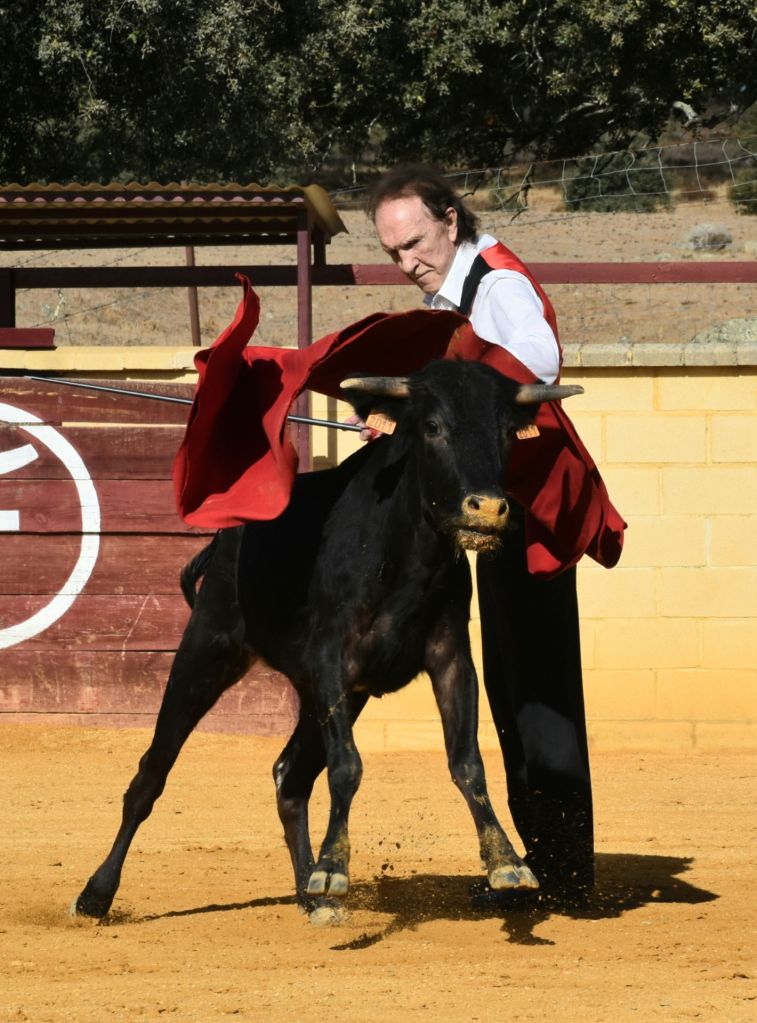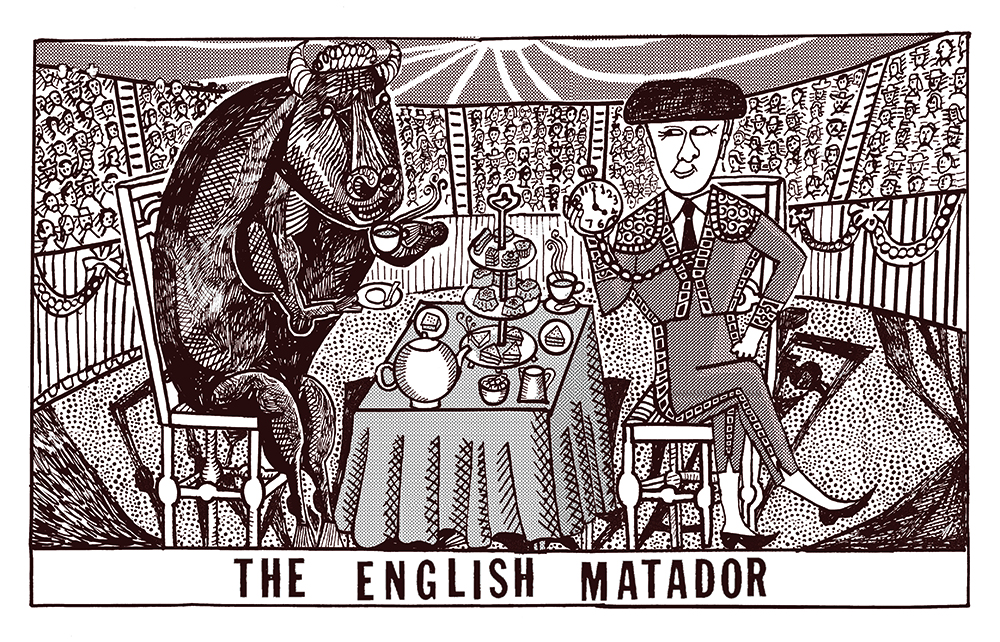It’s a sunny October morning at a bull-breeding ranch north of Seville, and 82-year-old Frank Evans is preparing to step into the ring. Born in Salford, Evans is one of the few British men ever to become a professional bullfighter, or torero. There is something of the retired rock star about him. He is dressed in the traditional matador’s outfit of black trousers, white shirt and red-and-black waistcoat. Although a little frail, he is toned. His thinning hair is dyed brown but still reaches his shoulders.
‘There are a million people in the local cemetery who’d love to have my eye problem’
Evans and I are here for a tienta – a practice session in a private bullring, in which young cows and bulls are assessed for breeding. The two-year-old females (vacas) that he will face aren’t as big as the four- or five-year-old males, but it would be a mistake to underestimate them. Last year, Evans was knocked to the ground and kicked in the face by a vaca. He was left with a broken cheekbone and eye socket, but the injury hasn’t deterred him: ‘There are a million people in the local cemetery who’d love to have my eye problem.’
When the tienta begins, and the first vaca comes racing out of the pens towards him, Evans’s assured movements are those of a much younger man. With his feet planted on the ground, he smoothly directs the animal past with a dark red cape (muleta). Poise is essential to good bullfighting – yet even experienced toreros can fail to achieve it. A few weeks before, at a bullfight in Antequera, I witnessed a dismal performance by one of Spain’s top bullfighters. He was unable to keep still as the animal passed him. Evans’s style, by comparison, is light and serene. It’s almost as if he is not there. After a few minutes, the cow is entirely focused on the muleta, apparently unaware that there’s someone behind it.
Despite the risks, these practice sessions are important to Evans. On the drive to the farm, he tells me ‘bullfighting is not just about putting on a nice suit on Sundays’ (when bullfights in small towns and villages usually take place). ‘It’s about the lifestyle. Going to ranches in Andalucia, in Madrid, in Salamanca, it’s marvellous, I just love all that.’
The athleticism that Evans demonstrates in the tienta is down to hard work and natural ability. At the age of 15, he set a record for the 80-yard hurdles, at 11.2 seconds, and in his early twenties he played rugby league for Sale, before the sport became professional. Between bouts in the ring, he has enough energy to demonstrate his hurdling technique to me. El Ingles, as he’s known in Spain, trains diligently for the tientas: ‘I do a little and often, like sex.’ Every morning, before breakfast, he runs up and down the stairs of either his Salford or Marbella home, and does several 50-metre sprints. He practises daily with his capes to maintain the strength in his arms.
Despite retiring from work in 2005 because he could ‘hardly walk’ due to an old rugby injury, Evans returned to the ring three years later, with a titanium knee and having had a quadruple heart bypass. He has no patience for people who express surprise: ‘Well what the fuck did they do the heart bypass for? They do these things so that you can carry on with your life.’

Evans attended his first bullfight in Granada in the 1960s at the age of 19. He was inspired to try bullfighting himself after he read the autobiography of Vincent Hitchcock, the first Brit to become a professional torero. Evans trained in Valencia and Barcelona and made his debut as a novillero (apprentice or junior bullfighter) in Montpellier in 1966, aged 23 – and that was only thanks to a mistake. As he puts it, ‘There was some other man going around as El Ingles’, a bullfighter called Henry Higgins. The promoter thought that he’d booked Higgins and ended up with Evans instead. By the time he realised his error, Evans had signed a contract to fight in France.
Still, Evans was unable to earn a living from bullfighting and returned to England in 1969. As well as investing in property and starting a kitchen business (which he still owns with his two sons), he acted as George Best’s unofficial business manager and second to the boxer Steve Foster. With some money in the bank, Evans was able to re-enter the ring in the 1980s, where he fought in Spain as a novillero again. Most of the other apprentices were young men, and Evans started to feel embarrassed that ‘I was going out there with kids and a bald patch’. Still, he persevered and finally became a full matador at a bullfight in Arles in 1991 – at 49, around the age when many toreros retire. In 2003, he achieved a career-high position of 63 in the official bullfighting rankings.
Evans estimates that he’s killed about 500 bulls over the course of his career, fighting in France, Spain, Mexico and South America. But now he’s advocating that the animal be dispatched backstage by gunshot, rather than in the ring by a sword thrust. Killing is one of the hardest and most dangerous parts of bullfighting, because the torero is required, by law, to go in over the horns and place the sword between the shoulder blades. If it’s done well, the bull dies within seconds. But, as Evans points out: ‘When you get a matador who’s incompetent, or frightened, or who lacks technique, the animal suffers.’ He says that botched kills are inhumane and that changing the rules would reduce the chances of bullfighting being banned in Spain, as it has been in Colombia.
There is, perhaps, a slight tension in Evans’s position on a ban in Spain. On the one hand, he argues that bullfighting must embrace change in order to survive: ‘You know with this last election we’ve just had? Labour think they won that, but they didn’t. The Conservatives lost it by their behaviour. This is what’s happening in bullfighting. These dickheads, the animal rights people, will win – not because they’re doing the right thing, but because the bullfighting world is doing the wrong thing.’
On the other hand, he considers animal rights agitators, especially those who wish injury and death to bullfighters, a ‘disgrace’. He points out that in the 1860s, during a visit to Spain: ‘Hans Christian Andersen went to a bullfight and hated it. Andersen said, “Don’t worry, there’s a group of people who have got together and they’re going to get it banned.” Well, that was 150 years ago and they still haven’t done it, because of how they behave.’
Evans continues to live a double life. He travels all over Spain to appear in tientas, and took part in another in Segovia before flying back to the UK. After almost 60 years in the ring, Evans has found the thrill of his vocation still hasn’t lost its allure. ‘Even the most complete matador has fear. We’re all frightened. And that in itself, in a funny way, is one of the enticements.’







Comments